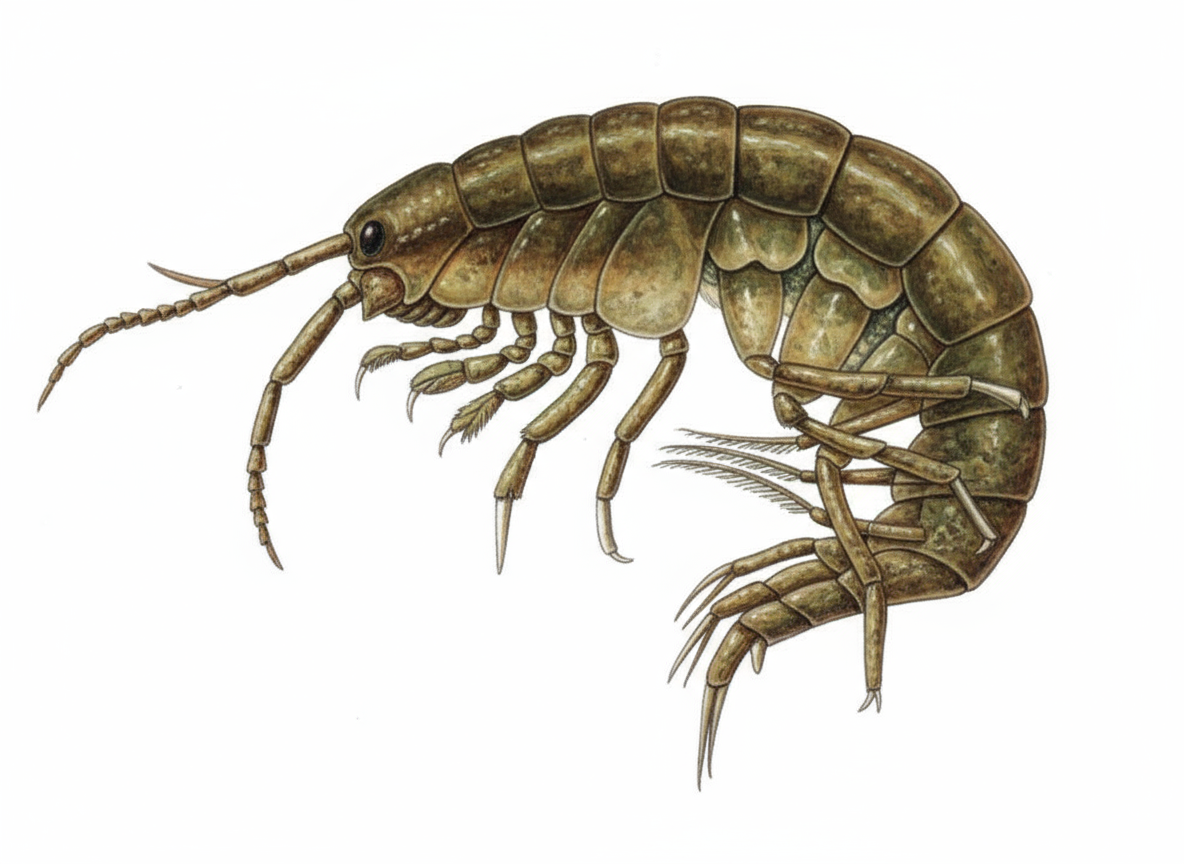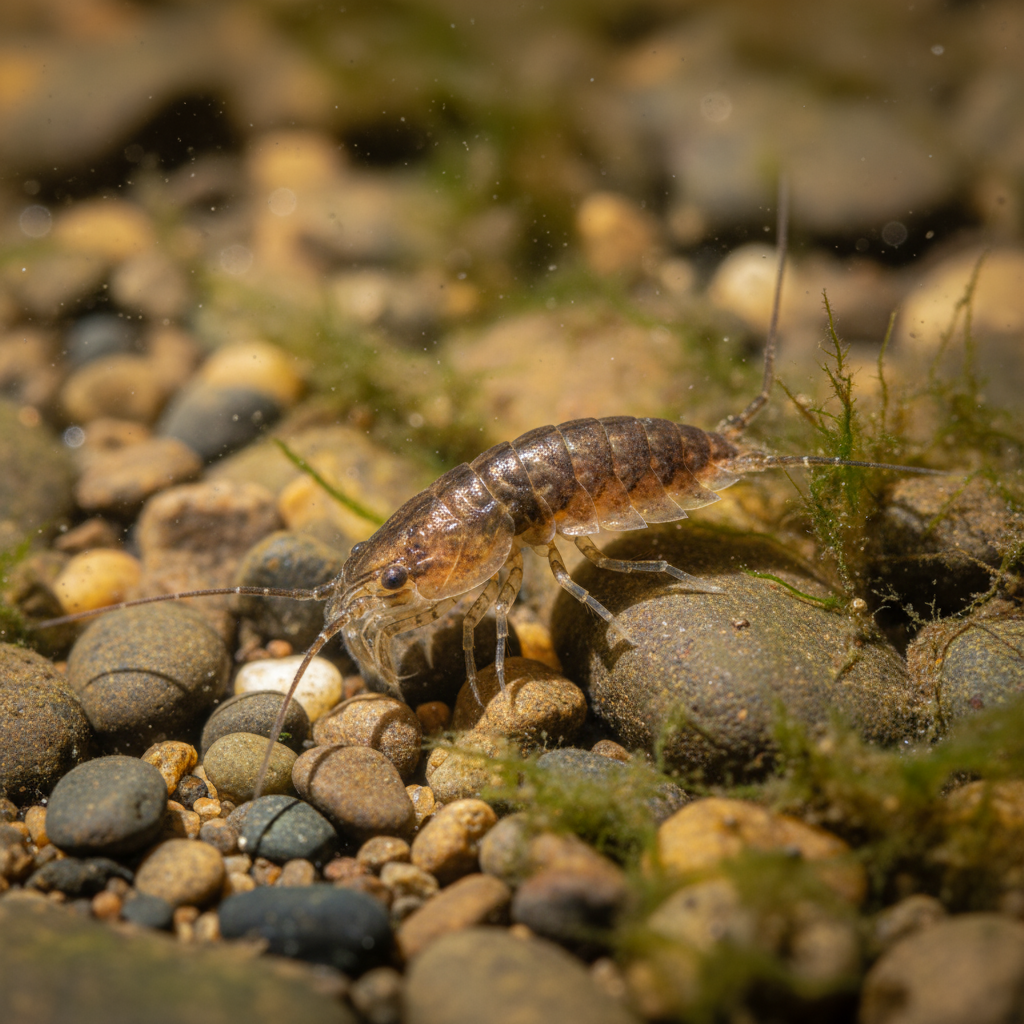Gammarus: Morphology, Classification, Habitat, and Ecological Role of Amphipod Crustaceans
Gammarus is a diverse genus of small, laterally compressed amphipod crustaceans belonging to the family Gammaridae. With over 200 described species, this genus is one of the most species-rich among crustaceans. Commonly referred to as “scuds,” Gammarus species are key components of freshwater, estuarine, and marine benthic communities across the Holarctic region and beyond. They play vital roles in aquatic food webs by feeding on detritus, algae, and small invertebrates, while serving as prey for fish and other predators.
Classification of Gammarus
| Taxonomic Rank | Name | Characteristics |
|---|---|---|
| Kingdom | Animalia | Multicellular eukaryotes |
| Phylum | Arthropoda | Segmented invertebrates with jointed appendages |
| Subphylum | Crustacea | Aquatic arthropods with chitinous exoskeleton |
| Class | Malacostraca | Largest class of crustaceans with diverse morphologies |
| Order | Amphipoda | Small, laterally compressed crustaceans |
| Family | Gammaridae | Amphipods with well-developed antennae and diverse forms |
| Genus | Gammarus | Common “scud” amphipods found in benthic aquatic habitats |

Habit and Habitat
Gammarus species inhabit a broad range of aquatic environments, including freshwater streams, rivers, lakes, estuaries, and coastal marine areas. Different species have specific preferences regarding salinity and temperature; for example, Gammarus pulex strictly inhabits freshwater, while Gammarus locusta thrives in brackish to marine waters with salinities above 25‰.
Typically, these amphipods reside under stones, among aquatic vegetation, or within sediment, where they play essential roles in the decomposition of organic matter and the cycling of nutrients. They prefer habitats rich in detritus and provide critical food resources for higher trophic levels.
Geographical Distribution
Gammarus is predominantly Holarctic, widely distributed across North America, Europe, and Asia. Some species also extend into northern tropical regions, especially in Southeast Asia. Their distribution correlates strongly with the availability of suitable benthic habitats and freshwater or estuarine conditions.

General Characteristics
- Commonly called as sand-flea or fresh-water shrimp.
- Body is bilaterally compressed and differentiated into head, thorax and abdomen.
- First thoracic segment is fused with head and without carapace Head appendages are antennules, antennae, mandibles, maxillulae, maxillae.
- First fused thoracic segment contains maxillipedes without epipodites and 7 free thoracic segments contain walking legs.
- First 2 pairs of legs are subchelate, the remaining are non-chelate, of which the first 2 pairs are directed forwards and the last three backwards.
- Second third pairs usually prehensile. Coxopodites of walking legs contain branchiae.
- Third and fourth abdominal segments are flexed ventrally.
- First three and the last three segments bear swimming pleopods and jumping uropods, respectively. The first three pairs of pleopods bear multiarticulate rami.
- Last three abdominal segments have bunches of small hairs. Posteriorly abdomen ends in a telson having deep cleft.
- Heart is thoracic.
- Sexes are separate.
- Fertilization is external. Eggs and embryos are carried by female which in tum are carried by males.
- Body Shape: Laterally compressed and segmented with a curved, flexible exoskeleton.
- Size: Usually ranges from a few millimeters to 2 centimeters in length.
- Antennae: Two pairs; long and sensory.
- Legs: Seven pairs of thoracic legs adapted for crawling and scavenging.
- Coloration: Variable; often translucent or brownish, blending with substrate.
- Eyes: Compound and well developed.
- Movement: Agile crawlers and swimmers with quick directional changes.
- Feeding: Omnivorous scavengers feeding on detritus, algae, and small invertebrates.
Special Features
- Ecological Indicator: Sensitive to pollution and used as bioindicators in freshwater ecosystems.
- Reproductive Strategy: Sexual reproduction with direct development; brood care under the female’s oostegites.
- Adaptability: Wide ecological tolerance, enabling survival in diverse aquatic settings.
- Behavior: Nocturnal and cryptic to avoid predation; some species exhibit aggressive territoriality.
- Life Span: Typically one to two years, varying by environmental conditions.

Identification
Identification of Gammarus species involves:
- Morphological examination of body segmentation, antennae, and gnathopods.
- Detailed study of uropods and telson shapes.
- Color patterns and size.
- Molecular techniques increasingly aid in resolving species complexes.
- Geographic range and habitat preferences.
Life Cycle and Reproduction
Gammarus reproduces sexually with separate sexes. Females carry eggs and developing embryos in a brood pouch formed by specialized appendages (oostegites). The young emerge as miniature adults, bypassing a larval stage. The reproductive cycle is tightly linked to environmental conditions, with peak reproduction in spring and summer.
Ecological Role and Importance
- Detritivores: Contribute to decomposition and nutrient cycling by consuming organic matter.
- Prey Species: Provide essential food for fish, birds, and other aquatic predators.
- Water Quality Indicators: Population structure and abundance reflect ecosystem health.
- Biodiversity: Support complex food webs and maintain ecosystem functioning.
- Research Applications: Model organisms for studying aquatic food webs, pollution effects, and invasive species dynamics.
Check sources
- https://en.wikipedia.org/wiki/Gammarus
- http://www.marinespecies.org/aphia.php?p=taxdetails&id=101537
- https://animaldiversity.org/accounts/Gammarus/classification/
- https://en.wikipedia.org/wiki/Gammarus_pulex
- https://racerocks.ca/gammarus-sp-scud-the-race-rocks-taxonomy/
- https://www.fws.gov/taxonomic-tree/21167
- https://www.ncbi.nlm.nih.gov/Taxonomy/Browser/wwwtax.cgi?mode=Info&id=52641
- https://www.sciencedirect.com/topics/biochemistry-genetics-and-molecular-biology/gammarus
- https://www.marinespecies.org/aphia.php?p=taxdetails&id=102281
- https://www.gbif.org/species/2219853
